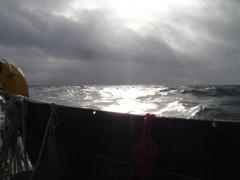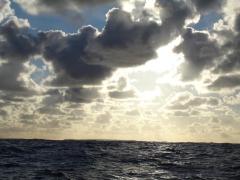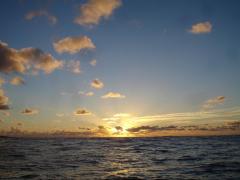A window in the weather recently made it possible to risk the Channel, to try out some Iron Age navigation methods (and to meet up with friends at YCC to discuss the centenary). For most of the way over, it was 'iron topsail' rather than Iron Age, though I did have a very pleasant goose-winged run for around three hours mid-Channel - a chance to admire a settled blue sky with scattered cumulus, and then, as the afternoon advanced, a fine sunset over the Alderney race, a definite sign of winter approaching!
A wet Monday in Cherbourg makes you understand the need for a 'parapluie'; the weather gave me the chance to shop, and see the new Michael Haneke film 'Amour', before going to dinner with Thierry and Anne in Urville, where we exchanged ideas about how to plan the centenary weekend visit to Cherbourg in 2013. Favourites were a 'round the Rade' race, to give people a chance to do a bit of tourism as well as race, and the idea of swapping crew members to mix the teams up a bit, both for racing and for nautical quizzes ashore afterwards, with a BBQ either on the terrace of the club or indoors if wet.
Reading a report of the ongoing archaeological investigations at Urville in the local paper, I was reminded of the regular trade that was carried on between the Cherbourg area and ports like Poole and Weymouth from a very early date. Interesting questions arise about how easy it was to make the crossing without even a compass and for how much of the year this was possible. There is published research on this subject, but there's only one way to see how correct its assumptions are!
Tuesday's brisk SSW wind, with limited visibility due to rain showers, gave me the chance I wanted, and I spent some hours trying to helm a straight line without a compass, Eventually, after about an hour, I found I could sail within a twenty degree vector with some ease, by sitting with my back to the wind, so that I could sense variations in course as much by feeling the wind shifting from one side to the other of my head, as from visual observation of the wind on the water. When the cloud cleared in front of me, I found that I had strayed a bit to the west, by naturally luffing up above course more than bearing away below it.
Seeing the whole, and easily identifiable, coastline from Golden Cap to Old Harry from about twelve miles off made me realise how completely Gallic pilots had fooled Julius Caesar by saying they knew nothing of the coast of Britain - and thereby saved their fellows across the Channel from Roman occupation for a further century.
Coming in between the Shambles and the Bill in the failing breeze was probably as easy then as now - picking up the beginning of the flood would have made rowing a bit easier, especially in the flat waters of Weymouth Bay. So long as they could row, the lack of wind would not have been a problem, once a good sighting had been obtained and the tide was favourable. A good local pilot would have been able to use the high ground behind the town as a marker, together with observation of the water, to tell where the Shambles bank was - probably as important a fishing ground then as now, and in calm weather not a problem anyway.
A great chance to open the winter cruising season, taken also by Dave Knight in 'Wizard', who had ideal crossing conditions for any age - a steady Easterly sector wind, 4-5, which blew him home in record time. It's good to see the W class still at sea, and great that conditions continue to permit great cruising as well as racing!
Steve Fraser
Submitted on 23rd November 2012



